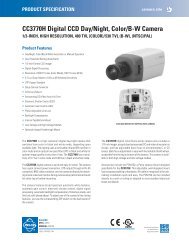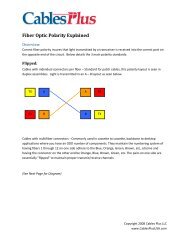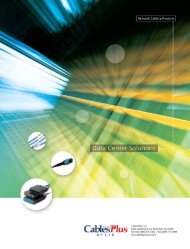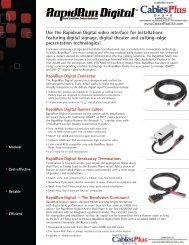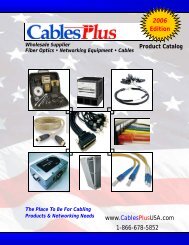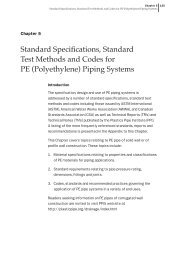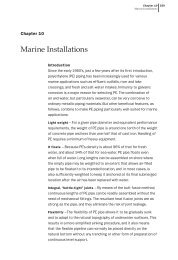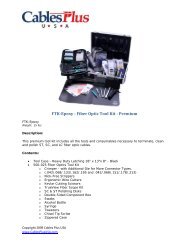Learning About Options in Fiber - Cables Plus USA
Learning About Options in Fiber - Cables Plus USA
Learning About Options in Fiber - Cables Plus USA
You also want an ePaper? Increase the reach of your titles
YUMPU automatically turns print PDFs into web optimized ePapers that Google loves.
With the use of splice holders, this type of splice can<br />
be used for temporary splices <strong>in</strong> both lab and field<br />
applications. By us<strong>in</strong>g a splice holder, the splice is<br />
easier to work with and has a substantially lower<br />
discard rate due to its alignment rod technique.<br />
SECTION 2—FIBER-OPTIC BASICS<br />
method uses match<strong>in</strong>g fluids or UV fluids depend<strong>in</strong>g<br />
on the application. The need for a good scribed<br />
optical fiber will allow for low attenuation measurements.<br />
A typical elastomeric splice will <strong>in</strong>troduce<br />
light loss of less than 1 dB/splice.<br />
For permanent <strong>in</strong>stallations, the hollow section with<br />
the rods is filled with UV fluid. After align<strong>in</strong>g the<br />
scribed fibers, the splice is cured <strong>in</strong> m<strong>in</strong>utes by<br />
us<strong>in</strong>g a UV lamp. Like all good splices, the<br />
process requires a good end face to ma<strong>in</strong>ta<strong>in</strong> low<br />
attenuation. The advantage of this type of splice<br />
are versatility for field and lab applications and low<br />
tool<strong>in</strong>g costs.<br />
Elastomeric Splice<br />
The elastomeric splice (Figure 2-23) is made from<br />
a plastic (elastic) material formed <strong>in</strong>to a mold. The<br />
mold allows for a hole to be made. The elastomeric<br />
material is flexible enough so the fibers<br />
can be positioned and firm enough so the fibers<br />
are reta<strong>in</strong>ed dur<strong>in</strong>g handl<strong>in</strong>g and splic<strong>in</strong>g without<br />
the need for position<strong>in</strong>g equipment.<br />
Because the fibers are mated <strong>in</strong>to the same mold,<br />
alignment can be ma<strong>in</strong>ta<strong>in</strong>ed with low attenuation.<br />
The fibers can be tuned for low attenuation if care<br />
is taken <strong>in</strong> remov<strong>in</strong>g the fibers prior to tun<strong>in</strong>g. Like<br />
the central glass alignment method, the elastomeric<br />
FIBER PREPARATION<br />
Proper preparation of the fiber end face is critical<br />
to any fiber-optic connection. The two ma<strong>in</strong> features<br />
to be checked for proper preparation are<br />
perpendicularity and end f<strong>in</strong>ish.<br />
The end face ideally should be perfectly square to<br />
the fiber and practically should be with<strong>in</strong> one or two<br />
degrees of perpendicular. Any divergence beyond<br />
two degrees <strong>in</strong>creases loss unacceptably. The fiber<br />
face should have a smooth, mirrorlike f<strong>in</strong>ish free<br />
from blemishes, hackles, burrs, and other defects.<br />
The two most common methods used to produce<br />
correct end f<strong>in</strong>ishes are the cleav<strong>in</strong>g (or scribeand-break)<br />
method and the polish method. The<br />
first is used with splices and the second is more<br />
commonly used with connectors.<br />
Whichever method is used, it is necessary to prepare<br />
a fiber for splic<strong>in</strong>g. To do this the protective jackets<br />
and buffers must be removed to allow access to the<br />
optical fiber. The outer and the <strong>in</strong>ner jackets are<br />
Figure 23—Elastomeric Splice<br />
Elastomer<br />
Inserts<br />
<strong>Fiber</strong><br />
Glass<br />
Sleeve<br />
End Guide<br />
<strong>Fiber</strong><br />
Insert Parts<br />
End Guide<br />
Outer<br />
Cyl<strong>in</strong>drical<br />
Sleeve<br />
Tempered<br />
Entrance Hole<br />
V-Groove<br />
2-21



